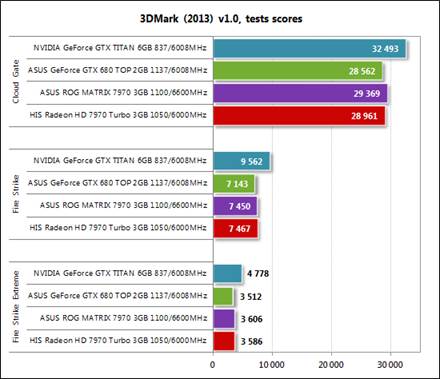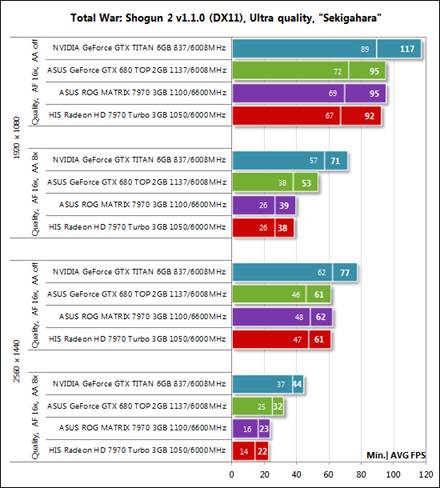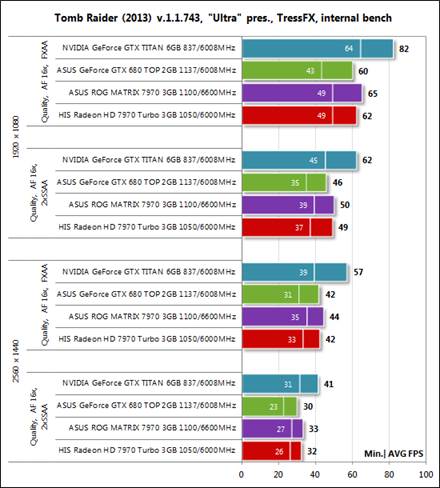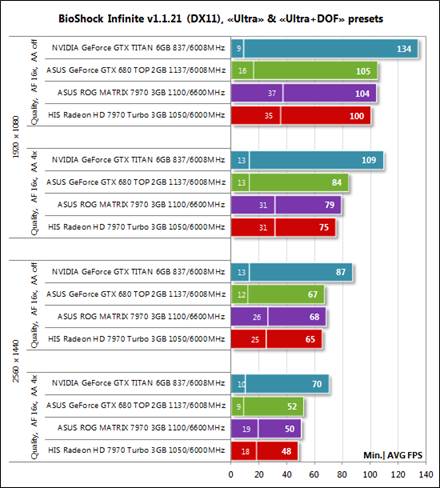Performance
3DMark
(2013)

Tested
by 3D Mark 2013
We can see the same image in each product
in three tests from the newest version of 3DMark. GeForce GTX Titan is
expected to be in the lead, next to be two samples Radeon from HIS and ASUS.
The latter is only faster than HD 7970 GHz Edition a little, so GPU
overclocking speed is to 50 MHz and the graphics memory frequency is to 600 MHz
that is not very beneficial. On the other hand, both of Radeon samples are
overclocked from producing compared to GeForce GTX 680 from ASUS, is really one
of the fastest GTX 680 models.
Unigine
Valley Bench
This benchmark shows us a different
picture:

Tested
by Unigine Valley Bench
GeForce GTX graphics card does not leave
any chance for its AMD platform rivals when the full-screen anti-aliasing
feature is not enabled. But as soon as we turn on 8x MSAA, only GeForce GTX
Titan still ahead while GeForce GTX 680 DirectCU II TOP ASUS is challenged
before Radeon HD 7970 GHz Edition.
Metro
2033: The Last Refuge
We will benchmark our graphics card with
Metro: Last Light was recently released at the end of the review but right
now let’s see what we had in the previous game series:

Tested
by Metro 2033
There is a gap between Nvidia GeForce GTX
Titan and three other graphics cards, but HD 7970 Radeon cards are faster than
GeForce GTX 680 samples that are overclocked in the production process. ASUS
ROG MATRIX 7970 is more 2-3% than HIS 7970 IceQ X² GHz.
Total
War: Shogun 2 – Fall of the Samurai
The standing is different in this game:

Tested
by Total War
Except Titan cards, three highest single
GPU graphics card provide the average frame speeds and at the bottom when antialiasing
turns off. But when we use 8x MSAA, GeForce GTX 680 goes ahead, therefore, the
below frame rate with GTX 680 is equivalent to the average frame rate of HD
7970 GHz Edition cards.
Battlefield
3

Test
by Battlefield 3
Again with the exception of titanium
samples, three other cards are almost the same in this game, that make the
average frame speed and the below speed are the same. ASUS is only higher 2 or
3% than HIS.
Sniper
Elite V2 Benchmark
We can see the same picture in this benchmark:

Tested
by Sniper Elite V2 Benchmark
Sleeping
Dogs

Test
by Sleeping dogs
AMD platform cards have the advantage in
this game. Radeon HD 7970, especially in the ASUS ROG Matrix 7970 version, can
challenge GeForce GTX Titan, although the difference between their prices is equivalent
to the price of a Radeon HD 7950 or GeForce GTX 670!
Hitman:
Absolution
We have got interesting result in this
game:

Tested
by Hitman: Absolution
Two Radeon cards make better with the
easiest setups but GeForce GTX Titan wins in another setup, just as expected.
AMD platform cards from ASUS and HIS beat ASUS Nvidia platform card.
Crysis
3

Tested
by Crysis 3
The Crysis 3 results consistent with the
overall picture about the relative performance of the graphics card.
Tomb
Raider (2013)
We can see the same result in Tomb Raider:

Tested
by Tomb Raider (2013)
BioShock
Infinite

Tested
by BioShock Infinite
BioShock Infinite has a very low bottom
speed on the Nvidia platform cards though their average frame speed is
acceptable. GeForce GTX 680 DirectCU II TOP ASUS successfully competes with HIS
7970 IceQ X ² GHz as well as the slightly faster than ASUS ROG Matrix 7970.
Metro:
Last Light
We run this game with the following picture
quality settings:

The
picture quality setting
This is the result:

Tested
by Metro: Last Light
Nvidia platform products have better
result, GeForce GTX 680 is enjoyed a bigger advantage than Radeon HD 7970 GHz
Edition. Let us check their speed when Advanced PhysX turns off:

Tested
by Metro: Last Light
As you can see, Radeon HD 7970 card looks
better in this game without advanced PhysX, begins to compete against GeForce
GTX 680. ASUS ROG Matrix 7970 is 2-3% faster than HIS 7970 IceQ X ² GHz while
GeForce GTX Titan version is a peerless champion.
Here is a table with full test result:

The
test result
Conclusions
ASUS ROG Matrix 7970 is not only the
fastest AMD platform single GPU graphics card. It is a functional and
feature-rich tool, can serve you to achieve a record performance in the tests
and different benchmark system. Choice of Champions slogan is applied to this
graphics card is very appropriate. It provides the unlimited possibility for
the maximum overclocking process.
It has a 20 phase power system with Super
Alloy Power technology. It allows you to adjust all voltages. It supports full
featured monitoring of each parameter via VGA Hotwire interface. It is equipped
with high efficiency cooling system with a maximum special speed mode. It has a
replaceable heat-sink electrical components for better cooling process. And it
supports up to six simultaneous monitor.
In addition to these are the importance
highlighting of DirectCU II cooling devices, Tweak GPU utilities, luxury
packaging with the rich accessories, and 3 year warranty. We could not find any
single flaw in its design, so we nominate ASUS ROG Matrix 7970 for anyone who
wants to set new performance records.
We are proud to award Editor’s
Choice for ASUS ROG Matrix 7970.
|
Specifications
·
Graphics processor: Tahiti XT “Southern Islands” TSMC
·
Production process, nm: 28 (low-k)
·
Die size, mm2: 365
·
Transistors, min: 4,313
·
GPU frequency, MHz: 3D: 1,050 (1,100-boost); 2D: 300
·
Unified shader processors: 2048
·
Texturing units: 128
·
Rasterization units (ROPs): 32
·
Max, theoretical fillrate, Gpixels/s: 35.2
·
Max, theoretical texture sampling rate, Gtexels/s: 140.8
·
Pixel Shaders/Vertex Shaders: 5.0/5.0
·
Supported memory type: GDDR5
·
Effective video memory frequency, MHz: 3D: 6,600; 2D: 600
·
Memory size, MB: 3072
·
Memory bus width, bit: 384
·
Memory bus bandwidth, GB/s: 316.8
·
Peak power consumption, w: 3D: 300; 2D: 70/3
·
PSU requirements, W: 650
·
Reference PCB dimensions (L*W*M), mm: 285×140×59
·
Interface: PCI-Express×16 (v3.0)
·
Uots: DVI-I +DVI-D (Dual-Link); HDMI v1.4a; 4 DisplayPort v1.2
·
MSRP/ min retail price: $549
|